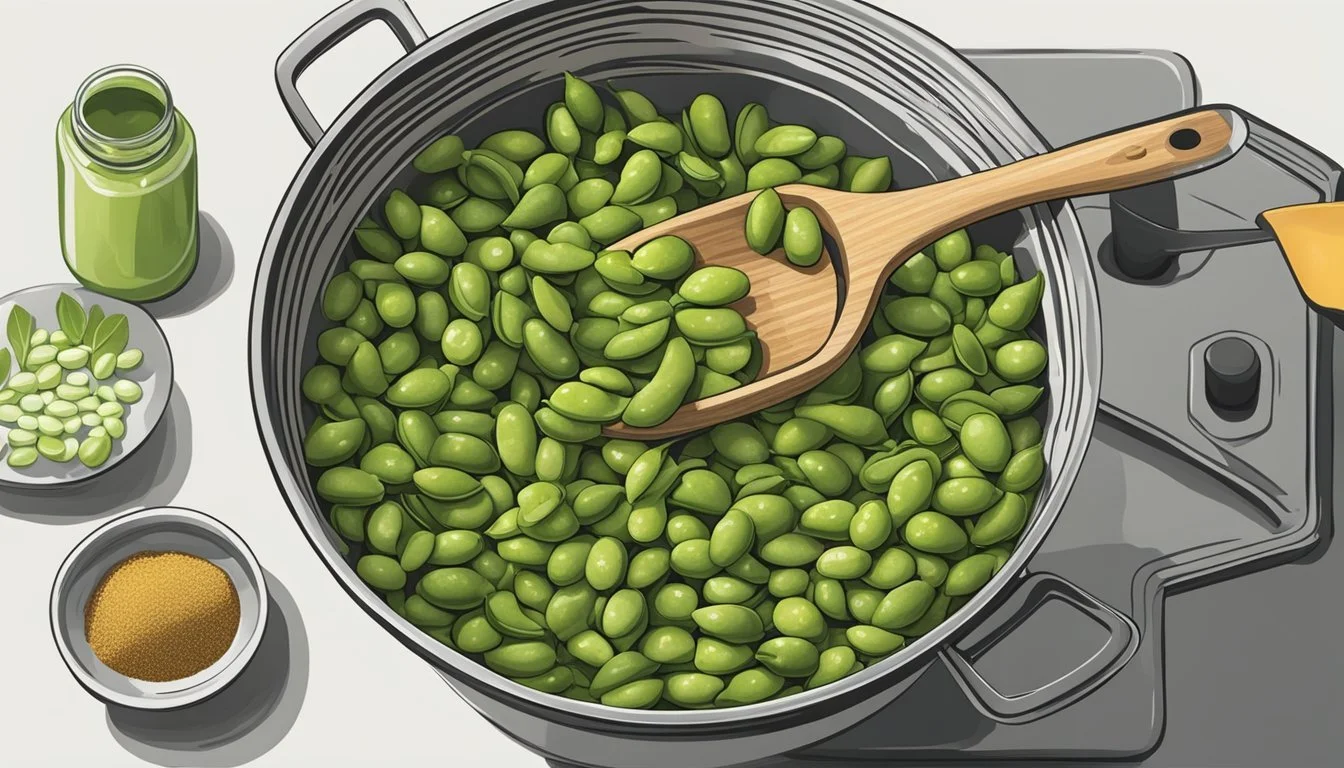Does Edamame Go Bad?
Understanding Shelf Life and Storage Tips
Edamame, a popular snack derived from immature soybeans, is not just a delicious addition to meals but also packs numerous health benefits. Rich in protein, fiber, and essential vitamins, edamame can support a balanced diet when stored properly. Yes, edamame can go bad if left out at room temperature for too long, which underscores the importance of proper storage.
When assessing whether edamame has spoiled, several signs can help determine its freshness. Fresh edamame typically features a bright green color, whereas spoiled edamame may appear discolored, with darkened or blackened beans. Additionally, changes in texture, such as a slimy or overly mushy consistency, can indicate that the beans are no longer edible.
To prolong its shelf life, it's best to store edamame in the refrigerator. Consuming it within a few hours if left out can prevent spoilage. Following these simple guidelines ensures that the nutritional benefits, including protein and fiber, remain intact, providing a tasty and healthy snacking option.
Understanding Edamame
Edamame, a staple in Asian cuisine, is not only valued for its versatility in culinary uses but is also highly regarded for its nutritional profile.
What Is Edamame?
Edamame are young, green soybeans that are harvested before they fully mature. Native to East Asia, edamame plays a significant role in traditional Asian diets. They are typically boiled or steamed in their pods and lightly salted before consumption. Unlike mature soybeans, edamame has a slightly sweet, nutty flavor. These soybeans are often enjoyed as a snack, appetizer, or added to various dishes for a nutritious boost.
Nutritional Profile
Edamame is packed with nutrients, making it a popular choice for health-conscious individuals. A one-cup serving provides around 188 calories, 8 grams of fat, and 17 grams of protein. This high protein content makes it an excellent plant-based protein source.
Additionally, edamame is rich in fiber, offering about 8 grams per serving, aiding digestion. It also contains essential vitamins and minerals such as iron, manganese, vitamin C, and vitamin K. These nutrients contribute to various health benefits like improved bone health and immune function.
Culinary Uses
Edamame's mild flavor and firm texture make it a versatile ingredient in the kitchen. It can be boiled or steamed and then sprinkled with sea salt for a simple, tasty snack. In addition, edamame can be added to soups, salads, and stir-fries or even blended into dips and spreads like hummus for added protein.
It's also useful as a meat substitute in vegetarian and vegan dishes. The ability to incorporate edamame into various recipes makes it a valuable ingredient for enhancing both the flavor and nutritional content of meals.
Health Aspects of Edamame
Edamame offers a range of health benefits from improving heart health to aiding in cancer prevention. Additionally, its rich nutrient profile supports bone health and enhances the digestive system.
Cardiovascular Benefits
Edamame is a low-saturated-fat food that can contribute to lowering cholesterol levels. The soy isoflavones in edamame are compounds that positively impact heart health by reducing LDL cholesterol and increasing HDL cholesterol. Additionally, edamame’s high fiber content helps to reduce the risk of heart disease by improving blood lipid profiles. It contains essential omega-3 fatty acids, which are known for their role in reducing inflammation and preventing arterial plaque buildup. This can help decrease the overall risk of cardiovascular diseases.
Cancer Prevention
Phytoestrogens, found abundantly in edamame, may play a crucial role in lowering cancer risk. These plant-based compounds mimic estrogen in the body and have been associated with reduced risks of breast and prostate cancer. Soy products like edamame contain isoflavones, which have antioxidant properties that protect cells from DNA damage. Regular consumption of edamame might also help in regulating hormone levels, thereby potentially reducing the incidence of hormone-related cancers. Though more research is needed, existing studies suggest that incorporating edamame into the diet could offer protective benefits against certain types of cancer.
Bone Health and Osteoporosis
Edamame is rich in nutrients that support bone health, including calcium, magnesium, and vitamin K. These nutrients are essential for maintaining bone density and preventing osteoporosis, a condition which weakens bones. Edamame’s isoflavones also play a role in bone metabolism, potentially increasing bone formation and reducing bone resorption. This is particularly beneficial for postmenopausal women, who are at higher risk for osteoporosis due to decreased estrogen levels. Consuming edamame regularly can contribute to stronger bones and lower the risk of fractures as it provides a plant-based source of essential minerals important for bone integrity.
Digestive Health
The high fiber content in edamame aids in promoting a healthy digestive system. Dietary fiber helps to improve bowel regularity, preventing constipation and supporting overall colon health. It also contributes to the growth of beneficial gut bacteria, which play a role in digesting food and absorbing nutrients. Moreover, edamame is a protein-rich food, providing a healthy alternative to animal-based proteins, which can be harder to digest for some individuals. This makes edamame an excellent addition to a diet aimed at supporting digestive health while offering multiple benefits beyond just its fiber content.
Signs of Spoilage
Edamame can spoil if not stored correctly, and identifying spoilage early can prevent foodborne illness. Key indicators include changes in color, texture, and smell.
Visual Indicators
Color: Fresh edamame should have vibrant green pods. Discoloration, such as brown or yellow spots, indicates spoilage.
Texture: The pods and beans should feel firm to the touch. A slimy texture is a clear sign of rot.
Smell: Off or sour smells suggest that edamame has gone bad. Fresh edamame should have a mild, earthy scent.
By paying attention to these indicators, one can ensure that the edamame being consumed is safe and fresh. It is crucial to discard spoiled edamame to avoid health risks.
Storage Guidelines
Ensuring edamame maintains its freshness requires proper storage techniques. The best practices involve refrigeration for short-term storage, freezing for long-term preservation, and avoiding room temperature conditions.
Refrigerating Edamame
Refrigeration is ideal for storing fresh edamame. Place edamame in an airtight container or freezer bag to prevent exposure to air, which can lead to oxidation and spoilage.
The ideal temperature for refrigeration is between 32°F to 38°F (0°C to 3.3°C). In these conditions, edamame can remain fresh for up to 2 days. Always store edamame in the crisper drawer for optimal humidity control. Remember to check for signs of spoilage such as an off smell or slimy texture.
Freezing Edamame
For longer storage, freezing is recommended. Blanch the edamame first by boiling for 2-3 minutes and then plunging into ice water. This process helps maintain texture and color.
After blanching, pat the edamame dry and transfer to an airtight container or freezer bags. Label with the date to track the storage time. Store at 0°F (-18°C) or lower. Properly stored, frozen edamame can last up to 12 months without significant quality loss. Be mindful of freezer burn, which can occur if the edamame is not properly sealed.
Pantry and Room Temperature
Edamame should not be stored at room temperature for extended periods. Exposure to room temperature accelerates spoilage, often within a few hours.
Leaving edamame on the counter, even for short durations, can lead to bacterial growth and a decrease in quality. If necessary, keep edamame at room temperature only briefly and plan to refrigerate it as soon as possible.
The ambient conditions of the pantry are not suitable for fresh edamame, which requires colder temperatures to slow the degradation process.
By following these storage methods, edamame can be enjoyed fresh and delicious, whether kept in the refrigerator or preserved in the freezer.
Preparing and Cooking
Preparing edamame involves selecting fresh pods or using frozen options, both requiring minimal cooking to enhance their flavor. Proper boiling and steaming techniques ensure they are cooked to perfection, making them a versatile ingredient for various dishes.
Boiling and Steaming
When boiling edamame, place the pods in a pot of heavily salted water. It's critical to use enough salt to season the beans during cooking. Boil the edamame for about 3-5 minutes, depending on the size of the pods.
After boiling, drain them well and avoid rinsing to preserve the salty flavor. Steaming is another excellent method. Place the edamame in a steam basket or colander and steam over boiling water for about 5-10 minutes until tender. Season with additional salt or spices and serve either warm or cooled.
From Freshness to Serving
Fresh edamame should be bright green and firm. If using frozen edamame, ensure they are still vibrant in color and free from freezer burn. Cooked edamame makes a perfect appetizer, simply seasoned with salt or soy sauce.
They can also be used in various dishes such as salads and as a complement to main courses. Edamame can even be blended to make a tasty hummus. Regardless of how they are served, the key lies in not overcooking, preserving their slight crunch and vibrant flavor.
Incorporating Edamame in Diets
Incorporating edamame into daily meals offers a variety of nutritional benefits, from high protein content to essential amino acids. This section explores how edamame can be a valuable addition to vegetarian and vegan diets.
Vegetarian and Vegan Considerations
Edamame is a key protein source for vegetarians and vegans, offering all essential amino acids. Unlike many plant proteins, edamame is a complete protein, making it an excellent alternative to meat.
In salads, it adds a nutritious crunch. For snacking, boiled edamame pods sprinkled with salt are a healthy choice.
Substitute tofu for edamame in stir-fries, or blend edamame into soy milk smoothies. However, the high intake might impact thyroid function due to antinutrients.
Adopting edamame in a balanced diet supports protein intake without relying on animal products.
Where to Buy Edamame
Grocery Stores
Edamame can be found in many local grocery stores. Look for both fresh raw edamame and frozen edamame options in the produce and frozen food sections. Shelled edamame is often available as a convenient option for various recipes.
Supermarkets
Large supermarkets often have a more extensive selection, including bulk options. Consumers can purchase fresh or frozen edamame packaged in various quantities. Many stores provide organic and non-GMO varieties.
Specialty Stores
Health food stores and Asian markets are excellent places to find a wide range of edamame products. These stores may offer unique brands or types not commonly found in regular supermarkets.
Online Retailers
For those who prefer online shopping, many websites offer fresh and frozen edamame, often with the added convenience of home delivery. Services like Amazon, Walmart, and other grocery delivery services provide a variety of options.
Farmer's Markets
Local farmers' markets can be a great source of fresh, locally grown edamame during the growing season. This can support local agriculture and ensure a fresh product.









